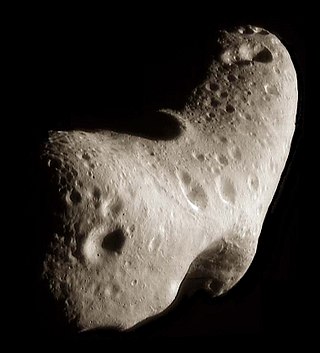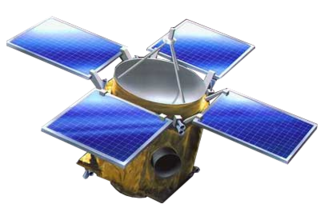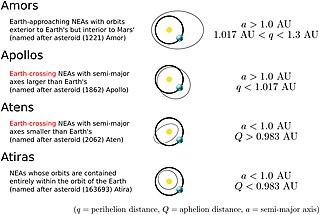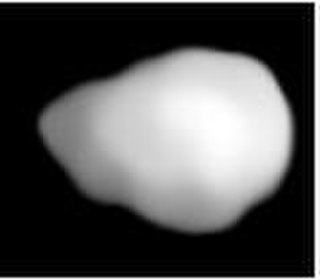
Eros is a stony asteroid of the Amor group, and the first discovered, and second-largest near-Earth object. It has an elongated shape and a volume-equivalent diameter of approximately 16.8 kilometers. Visited by the NEAR Shoemaker space probe in 1998, it became the first asteroid ever studied from its own orbit.

Near Earth Asteroid Rendezvous – Shoemaker, renamed after its 1996 launch in honor of planetary scientist Eugene Shoemaker, was a robotic space probe designed by the Johns Hopkins University Applied Physics Laboratory for NASA to study the near-Earth asteroid Eros from close orbit over a period of a year. It was the first spacecraft to orbit an asteroid and land on it successfully. In February 2000, the mission closed in on the asteroid and orbited it. On February 12, 2001, Shoemaker touched down on the asteroid and was terminated just over two weeks later.

Vesta is one of the largest objects in the asteroid belt, with a mean diameter of 525 kilometres (326 mi). It was discovered by the German astronomer Heinrich Wilhelm Matthias Olbers on 29 March 1807 and is named after Vesta, the virgin goddess of home and hearth from Roman mythology.

Ida, minor planet designation 243 Ida, is an asteroid in the Koronis family of the asteroid belt. It was discovered on 29 September 1884 by Austrian astronomer Johann Palisa at Vienna Observatory and named after a nymph from Greek mythology. Later telescopic observations categorized Ida as an S-type asteroid, the most numerous type in the inner asteroid belt. On 28 August 1993, Ida was visited by the uncrewed Galileo spacecraft while en route to Jupiter. It was the second asteroid visited by a spacecraft and the first found to have a natural satellite.

Eugene Merle Shoemaker was an American geologist. He co-discovered Comet Shoemaker–Levy 9 with his wife Carolyn S. Shoemaker and David H. Levy. This comet hit Jupiter in July 1994: the impact was televised around the world. Shoemaker also studied terrestrial craters, such as Barringer Meteor Crater in Arizona, and along with Edward Chao provided the first conclusive evidence of its origin as an impact crater. He was also the first director of the United States Geological Survey's Astrogeology Research Program.

The Amor asteroids are a group of near-Earth asteroids named after the archetype object 1221 Amor. The orbital perihelion of these objects is close to, but greater than, the orbital aphelion of Earth, with most Amors crossing the orbit of Mars. The Amor asteroid 433 Eros was the first asteroid to be orbited and landed upon by a robotic space probe.

Auguste Honoré Charlois was a French astronomer who discovered 99 asteroids while working at the Nice Observatory in southeastern France.

Carl Gustav Witt was a German astronomer and discoverer of two asteroids who worked at the Berlin Urania Observatory, a popular observatory of the Urania astronomical association of Berlin.
This is a directory of lists of geological features on planets excepting Earth, moons and asteroids ordered by increasing distance from the Sun.

Daphne is a large asteroid from the asteroid belt. It is a dark-surfaced body 174 km in diameter is probably composed of primitive carbonaceous chondrites. The spectra of the asteroid displays evidence of aqueous alteration. It was discovered by H. Goldschmidt on May 22, 1856, and named after Daphne, the nymph in Greek mythology who was turned into a laurel tree. Incorrect orbital calculations initially resulted in 56 Melete being mistaken for a second sighting of Daphne. Daphne was not sighted again until August 31, 1862.
William Stephen FinsenFRAS was a South African astronomer. He discovered a number of double stars and took many photographs of Mars. He developed the Finsen eyepiece interferometer to measure very close double stars. He was the final director of Union Observatory in South Africa from 1957 to 1965.

1221 Amor is an asteroid and near-Earth object on an eccentric orbit, approximately 1 kilometer (0.6 miles) in diameter. It is the namesake of the Amor asteroids, the second-largest subgroup of near-Earth objects. It was discovered by Eugène Delporte at the Uccle Observatory in 1932, the first time that an asteroid was seen to approach Earth so closely. The assumed S-type asteroid is one of few low-numbered asteroids for which no rotation period has been determined. It was assigned the provisional designation 1932 EA1 and named for Cupid, also known as "Amor" in Latin, the Roman equivalent of the Greek god Eros.

Asteroid is a 1997 NBC TV miniseries about the United States government trying to prevent an asteroid from colliding with the Earth. The miniseries aired February 16–17, 1997.

The L type ordinary chondrites are the second most common group of meteorites, accounting for approximately 35% of all those catalogued, and 40% of the ordinary chondrites. The ordinary chondrites are thought to have originated from three parent asteroids, with the fragments making up the H chondrite, L chondrite and LL chondrite groups respectively.

According to the International Astronomical Union (IAU), a minor planet is an astronomical object in direct orbit around the Sun that is exclusively classified as neither a planet nor a comet. Before 2006, the IAU officially used the term minor planet, but that year's meeting reclassified minor planets and comets into dwarf planets and small Solar System bodies (SSSBs). In contrast to the eight official planets of the Solar System, all minor planets fail to clear their orbital neighborhood.
Eros Glacier is a glacier on the east coast of Alexander Island, Antarctica, 7 nautical miles (13 km) long and 2 nautical miles (4 km) wide at its mouth, flowing southeast from the Planet Heights into George VI Sound immediately north of Fossil Bluff. It was probably first seen on November 23, 1935, by Lincoln Ellsworth, who flew directly over the glacier and obtained photos of features north and south of it. The mouth of the glacier was observed and positioned by the British Graham Land Expedition in 1936 and the Falkland Islands Dependencies Survey (FIDS) in 1948 and 1949. The glacier was mapped in detail from air photos taken by the Ronne Antarctic Research Expedition, 1947–48, by D. Searle of the FIDS in 1960. It was named by the UK Antarctic Place-Names Committee after the minor planet Eros in association with nearby Pluto Glacier and Uranus Glacier.

Leviathan Wakes is a science fiction novel by James S. A. Corey, the pen name of American writers Daniel Abraham and Ty Franck. It is the first book in the Expanse series, followed by Caliban's War (2012), Abaddon's Gate (2013) and six other novels. Leviathan Wakes was nominated for the 2012 Hugo Award for Best Novel and the 2012 Locus Award for Best Science Fiction Novel. The novel was adapted for television in 2015 as the first season-and-a-half of The Expanse by Syfy. Five short stories that take place before, during, or after Leviathan Wakes were published between 2011 and 2019.

The NWA 3009 meteorite was found in Northwest Africa during 2001.
Clementine 2 was a proposed asteroid-interception mission that was intended to fly by two near-Earth asteroids, 433 Eros and 4179 Toutatis planned by NASA.